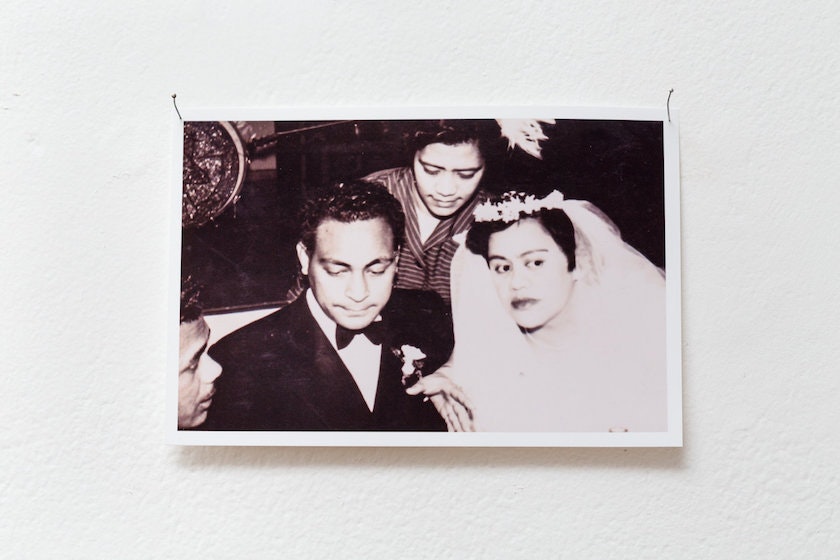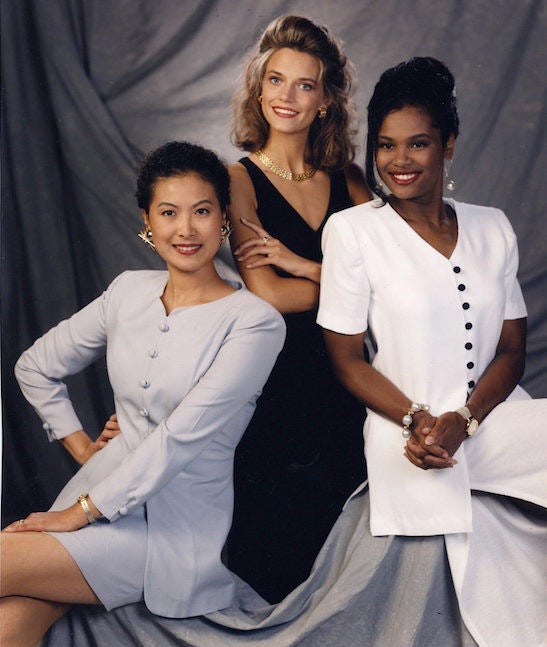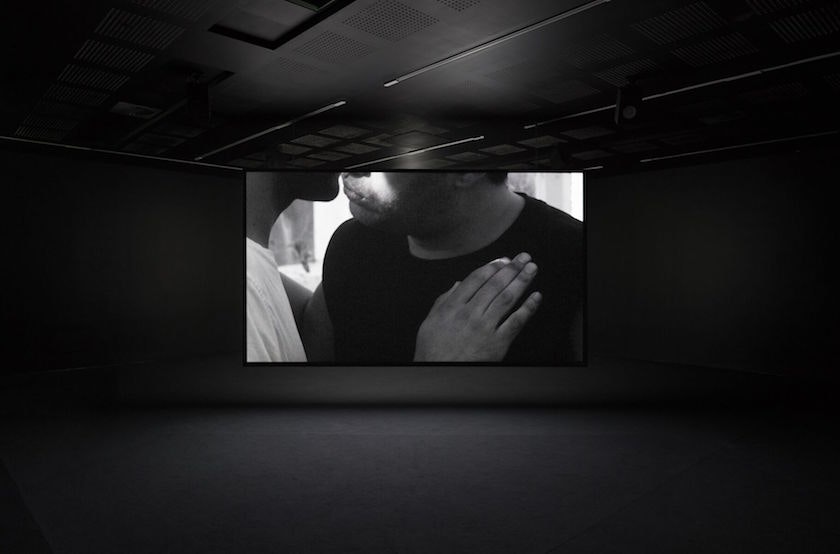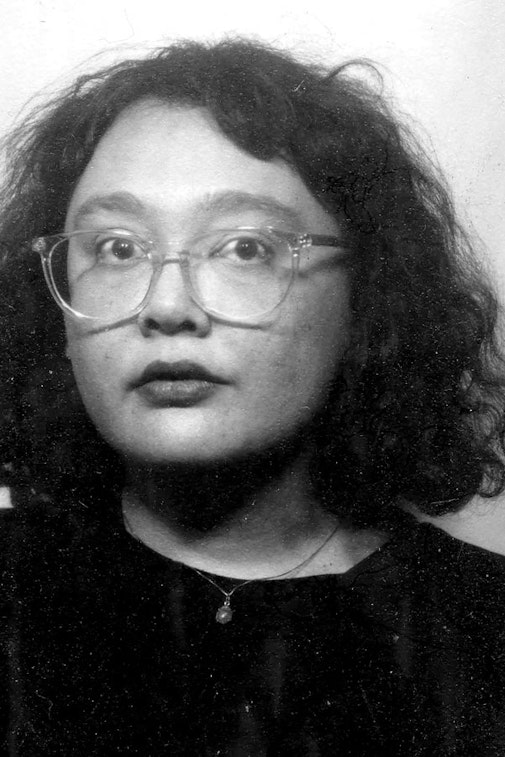Salt/Tears/Water
Talia Smith
I. Salt
As a child I loved to pull out the family photo albums and sit with my mother, asking her who each person was and the story behind each image. I had heard the stories many times, but I loved the anticipation of the moment when a laugh would erupt or where Mum would get quiet and I knew that this was a moment or a person that was not around anymore. The quiet moments happened more often with one particular album; its black paper pages were filled with predominantly black-and-white images. Some faces I recognised, some I did not.
This was my mother’s family photo album, and it had photographs of my grandparents when they first met. Drinking with other family members at a social, cigarettes in hand, my grandmother smiling, probably a little tipsy, my grandfather handsome and with the air of arrogance that only youth (or being a very proud Sāmoan man) can bring.
There were also photos of their very first house in Ponsonby, Auckland, (1) and then eventually their family home in Avondale, Auckland—where my mother was born. I remember one particular photo vividly, of all of the seven siblings out the front of the house. Ranging in ages, some were toddlers and some just babies. My mother, the darkest skin tone of them all (and nicknamed ‘Blackie’ because of it), sitting with a slightly exasperated look on her face, a look that I have inherited.
There are few photos of my grandmother; she passed away when Mum was 18 and I never had the chance to meet her. Yet she appears in my writing and artwork all the time, and she has been a presence in my life for as long as I can remember, brought to life through the few photos and anecdotes that my mum and her siblings would tell.
In Roland Barthes’ seminal text Camera Lucida (1980) he writes about the moment he finds a photograph of his mother as a child: ‘The photograph was very old. The corners were blunted from having been pasted into an album, the sepia print had faded, and the picture just managed to show two children standing together at the end of a little wooden bridge in a glassed-in conservatory, what was called a Winter Garden in those days.’ (2) However the reader is not able to see this image as he chooses not to include a reproduction in the book. Instead this exclusion means that we are then transported to our own moments of loss and grief. After looking through many photographs of his mother it is this particular one that truly spoke to Barthes’ memory of her, despite seeing many that showed her true likeness at a point in her life. It is interesting the way that an image can evoke such feelings of grief, loss, love and is, at times, destabilising. Perhaps that is what always drew me to that family album; the faces in the photos spoke of a time that I would never know, and maybe that was the loss and grief that I searched for in each image.

Left: Ignasio Timo and Tutai’i Timo (writer’s grandparents) at their wedding; installation image: Document Photography, courtesy the writer.
II. Tears
Daniel C. Blight explores the multi-layered concept of Whiteness in terms of society and also its relationship to photography through his writings and essays. In particular, he states that ‘Whiteness is a social force, not a skin colour.’ (3) And that, ‘It is not our skin that makes us white, but rather the way we act upon the world.’ (4) Although Blight comes at this from the perspective of being a white man, his research posits that because of the way society has developed to allow Whiteness as a force rather than just skin colour, in everything that we do, no matter our intention, there will always be an inherent bias towards whiteness.
This bias, in terms of the art sector, is represented through the lack of diversity seen in art galleries, collections and leadership roles. In Diversity Arts Australia’s report ‘Shifting the Balance’ (2019) their findings show that despite the fact that culturally and linguistically diverse (CALD) audiences have higher-than-average attendance and participation rates within the arts in comparison to other Australians, they are still heavily under-represented in leadership positions in galleries and museums.
With this in mind and turning the focus particularly on photography and its history, Blight writes in his book The Image of Whiteness that, ‘The technology of the camera has never been innocent or neutral—photography both constructs and images whiteness.’ (5) He elucidates further on this by referencing the research of professor Lorna Roth of Concordia University, Montreal, on the invention of Kodak’s colour film. . Roth traced the history of the development of colour film concluding that a white female skin tone was the ‘standard’ or default, which meant that the diversity of skin colour was never captured properly within photographs. (6) Roth also found that Kodak was forced by chocolate and furniture companies to confront the inaccuracies within its colour film, and notes that Earl Kage, a former manager at Kodak, responded, ‘It was never black flesh that was addressed as a serious problem at the time.’ (7)
Professor Sarah Lewis comments further: ‘By categorising light skin as the norm and other skin tones as needing special corrective care, photography has altered how we interact with each other without us realizing it.’ (8) Through her own research into the inherent racial bias of photography, she found that when Kodak released their Gold Max film it was touted as being, ‘ “able to photograph the details of a dark horse in lowlight”, a coded message for being able to photograph people of color.’ (9)

Kodak’s multiracial ‘Shirley’ card, 1996; image: Kodak via Lorna Roth.
However, the marginalisation of people of colour happened from a much earlier point. From the mid-1850s photography was used as an ethnographic tool by colonisers and explorers to categorise or Other those from backgrounds that were different to their own. This stripped the subjects of their identity and authorship; more often than not they would be without names or identifiers, relegated to being titled simply as a ‘woman’ or ‘man’. (10) The complexities of culture were largely ignored in favour of identifying that which was different to what was considered ‘normal’.
In The Image of Whiteness, Blight acknowledges that through the lack of prominence for stories not skewed by a colonial view, the history of photography and therefore culture has become dominated by the aggressor. It is the norm and is ‘overshadowing the work of local and residency photographers and eventually, the growing number of indigenous photography archives seldom subject to detailed study in Western photography textbooks.’ (11) With this thinking, future archives, much like a lot of that being produced today, will not reflect a true representation of history, and therefore multifaceted experiences, voices and cultures will continue to be written out of the history of art.
‘Decolonising’ is a term that has become commonplace in academia and especially in the art sector. It is defined as becoming independent from the coloniser, which means its hierarchies and structures, to take back ownership of identity and culture. With this in mind, writer and historian Mark Anthony Sealy states in his book Decolonising the Camera: Photography in Racial Time: ‘A key function of decolonising the camera is to not allow photography’s colonial past and its cultural legacies in the present to lie unchallenged and un-agitated, or to be simply left as an unquestioned chapter within the history of the medium.’ (12) Both Sealy and Blight are asking us to challenge the history of photography that has already been written. It is to not ignore what has been said before but rather to open the conversation and create inclusion within the telling of such history. To decolonise is to challenge, to listen and to share.
Perhaps that is what always drew me to that family album; the faces in the photos spoke of a time that I would never know, and maybe that was the loss and grief that I searched for in each image.
III. Water
Fact-based research may outweigh personal testimonies in traditional Western methodology but the vitality and richness of oral history lies in its ability to add texture while offering nuanced observations of the past. (13)
Using the work of Barby Asante, Libita Clayton and Ashley Holmes, writer Kadish Morris looks to outline the ways in which these artists of colour are making works that look to ‘challenge’ and ‘agitate’ Western structures of academia and art. He makes the argument that ‘fact-based’ research is what is known to be a true account or representation of history. However, as Morris points out, for some non-Western cultures which are predominantly oral, this kind of ‘fact-based’ approach cannot capture or convey the true history of a people.
If I think of my own culture, I am of Sāmoan and Cook Island heritage. I am second-generation New Zealand born. I do not speak either language and both of my grandparents are no longer alive. With the waves of migration comes new experiences, and histories are altered and shaped within these new contexts. This is where the importance of ‘personal testimonies’ comes into play: the sharing of my family’s history has been largely oral with few recorded details. This personal sharing should not negate it as fact, and perhaps another facet of challenging or agitating the Western or colonial history of photography is to also allow for artists to articulate their histories through culturally appropriate ways.
The importance of artists of colour developing their voices through lens-based practices is articulated by Morris when speaking about Barby Asante’s work:
Asante’s personal experiences pervade her practice—rightly so, given how little airtime the media affords black women. For example, John Ridley’s six-part mini-series, ‘Guerilla’ (2017), which dramatizes the British Black Power movements of the 1970s, features no black women in prominent roles and is just one instance among many that erases marginalized peoples’ contributions to significant political moments. This is why it is paramount that we tell our own stories. For those who have been ignored by traditional outlets or platforms, being candid and confessional is always a radical act. (14)
Ngāti Tūwharetoa artist Shannon Te Ao’s moving-image practice explores the failings of translation, language, the grief of the past on the present and relationships to land, history and each other. He also weaves Te reo—Māori language—into his work. I first saw Te Ao’s work My Life as a Tunnel (2018) in the recent exhibition O le ua na fua mai manu’a, curated by Léuli Eshrāghi at UNSW Galleries. The exhibition appeared as part of Wansolwara: One Salt Water and looked to present perspectives on language and its sensitivities or movements through those who call the Great Ocean home, from Aotearoa New Zealand to Canada to Australia. There are works that speak through the language of bodies, limbs and gestures, and there are works that speak through mouths and whispers.

Shannon Te Ao, my life as a tunnel, 2018. Two-channel HD video with sound, 9:48 minutes. Installation view, ‘O le ūa na fua mai Manu’a, UNSW Galleries, 2020. Photo: Zan Wimberley.
Walking through the main gallery to a darkened room at the back of the exhibition, a lone angled screen in the middle of the room plays a black-and-white video of two men embracing, slowly swaying and moving. A Māori waiata can be heard as the two men shuffle together. As someone familiar with Te Ao’s work, I know that this is referencing the Charles Burnett film Killer of Sheep (1978) and, in particular, a scene where the two main characters awkwardly embrace in front of a window to the sound of ‘This Bitter Earth’ by Dinah Washington. The scene is devastating, the gap between the couple widening as she desperately clings onto her husband and he stiffens to her touch, eventually pushing her away and walking out of the room as the song ends.
Eshraghi comments that the waiata featured in Te Ao’s Life as a tunnel goes ‘ … back and forth between English and reo Māori into the deeply poetic musical form mōteatea’. A mōteatea is a centuries-old tradition of chanted song-poetry that was often composed to call on gods or spirits. However it is more than the definition my Google translation suggests. This is where the nuances of culture cannot always be captured by Western ideologies and it is important to acknowledge the traditions passed down from the people themsleves. In a close analysis of the work, curator and writer Matariki Williams commented that:
Mōteatea are written to respond to particular moments, but the ways in which they are performed, through chanting, singing, lamentations, transcend the circumstances in which they were written. With this in mind, I am not surprised that Te Ao has chosen this poetically rich format as a method through which to transmit knowledge, for that is what mōteatea were made for. (15)
In this version it is Tūhoe actor Tola Newberry and Tainui-iTaukei Viti actor Scott Cotter who sing the mōteatea. The subversion of two men embracing in such a gentle way challenges the stereotypes of the ‘hard and tough’ brown man: there Is softness in their touch and softness in the lighting. It feels private and yet it isn’t—it is a two-channel video work on a large screen, and we have been made privy to the intimate moment. It isn’t until much later when I am talking with colleagues about the work and have had time to think about it, that I realise, yes, there is softness but there is also the darkness of desire. The kind of darkness of yearning that claws at your stomach, gnawing away until you cannot take it any longer. Sometimes the desire for someone can be like wanting to consume them—nothing will satisfy you.
I think of the way the woman in Killer of Sheep clutches desperately onto her husband, trying to push her body onto his, her mouth gliding along his arm and neck as he stands stiffly, his face looking into the distance—he is neither here nor there. I then think of Te Ao’s film. There is a moment where one of the men clutches at the neck of the white t-shirt of the other as he looks away. I think about once in a previous relationship, not being able to speak when I needed to. I could not articulate what I wanted to say and even though everything was falling apart all I could do was reach out and touch him, his bare arm that was warm and soft, like that would somehow say everything that I could not. But it didn’t and he left.
With the use of te reo Māori in My Life as a Tunnel, Te Ao claims space. Although we as the audience are given the knowledge that this is a translation of a song, there are no subtitles or script handed to visitors. To hear the moteatea as it is meant to be said—without English translations—is to gain some understanding of the many intricate nuances of Māori culture that can only be represented through the language that is indigenous to it. These are the ways in which artists of colour are reclaiming the camera—whether moving or still—to assert their histories and stories within the Western-dominated discourse.
Notes
(1) The majority of Pacific migrants first settled in the suburb of Ponsonby. By the 1980s and ‘90s gentrification had pushed most of these families to West or South Auckland.
(2) Roland Barthes, Camera Lucida: Reflections on Photography, trans. Richard Howard, Hill and Wang/Farrar, Straus & Giroux, New York, 1981; originally published in French, 1980.
(3) https://danielcampbellblight.work/How-do-white-people-see.
(4) https://danielcampbellblight.work/Perfect-White-Family.
(5) Daniel C. Blight (ed.), The Image of Whiteness: Contemporary Photography and Racialization, Self Publish, Be Happy, 2019, London, 22.
(6) Ibid.
(7) https://www.nytimes.com/2019/04/25/lens/sarah-lewis-racial-bias-photography.html. Accessed 31 March 2020.
(8) Ibid.
(9) Ibid.
(10) Daniel C. Blight, op. cit.
(11) Ibid.
(12) Mark Sealy, Decolonising the Camera: Photography in Racial Time, Durham University, Durham, 2016.
(13) https://frieze.com/article/how-artists-are-using-power-personal-histories-tackle-legacy-colonialism. Accessed 31 March 2020.
(14) https://frieze.com/article/how-artists-are-using-power-personal-histories-tackle-legacy-colonialism. Accessed 31 March 2020.
(15) https://www.pantograph-punch.com/post/singing-word. Accessed 31 March 2020.
About the contributor
Talia Smith is a curator and artist from New Zealand Aotearoa and is currently based in Sydney, Australia.
